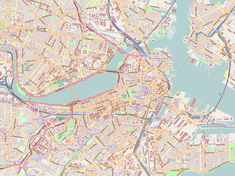The Boston Massacre was a confrontation on March 5, 1770, in which British soldiers shot and killed several people while being harassed by a mob in Boston. The event was heavily publicized by leading Patriots such as Paul Revere and Samuel Adams. British troops had been stationed in the Province of Massachusetts Bay since 1768 in order to support crown-appointed officials and to enforce unpopular Parliamentary legislation.

Haverhill is a city in Essex County, Massachusetts, United States. Haverhill is located 35 miles north of Boston on the New Hampshire border and about 17 miles from the Atlantic Ocean. The population was 60,879 at the 2010 census.

Sir Francis Bernard, 1st Baronet was a British colonial administrator who served as governor of the provinces of New Jersey and Massachusetts Bay. His uncompromising policies and harsh tactics in Massachusetts angered the colonists and were instrumental in the building of broad-based opposition within the province to the rule of Parliament in the events leading to the American Revolution.

James Bowdoin II was an American political and intellectual leader from Boston, Massachusetts, during the American Revolution and the following decade. He initially gained fame and influence as a wealthy merchant. He served in both branches of the Massachusetts General Court from the 1750s to the 1770s. Although he was initially supportive of the royal governors, he opposed British colonial policy and eventually became an influential advocate of independence. He authored a highly political report on the 1770 Boston Massacre that has been described by historian Francis Walett as one of the most influential pieces of writing that shaped public opinion in the colonies.
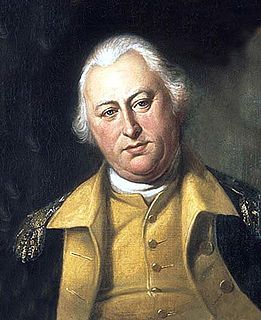
Benjamin Lincoln was an American army officer. He served as a major general in the Continental Army during the American Revolutionary War. Lincoln was involved in three major surrenders during the war: his participation in the Battles of Saratoga contributed to John Burgoyne's surrender of a British army, he oversaw the largest American surrender of the war at the 1780 Siege of Charleston, and, as George Washington's second in command, he formally accepted the British surrender at Yorktown.

The Province of New York (1664–1776) was a British proprietary colony and later royal colony on the northeast coast of North America. As one of the middle Thirteen Colonies, New York achieved independence and worked with the others to found the United States.

The Province of Massachusetts Bay was a colony in British America which became one of the thirteen original states of the United States. It was chartered on October 7, 1691 by William III and Mary II, the joint monarchs of the kingdoms of England, Scotland, and Ireland. The charter took effect on May 14, 1692 and included the Massachusetts Bay Colony, the Plymouth Colony, the Province of Maine, Martha's Vineyard, Nantucket, Nova Scotia, and New Brunswick; the Commonwealth of Massachusetts is the direct successor. Maine has been a separate state since 1820, and Nova Scotia and New Brunswick are now Canadian provinces, having been part of the colony only until 1697.

Thomas Cushing III was an American lawyer, merchant, and statesman from Boston, Massachusetts. Active in Boston politics, he represented the city in the provincial assembly from 1761 to its dissolution in 1774, serving as the lower house's speaker for most of those years. Because of his role as speaker, his signature was affixed to many documents protesting British policies, leading officials in London to consider him a dangerous radical. He engaged in extended communications with Benjamin Franklin who at times lobbied on behalf of the legislature's interests in London, seeking ways to reduce the rising tensions of the American Revolution.

Sir William Pepperrell, 1st Baronet was a merchant, soldier, and slaveholder in colonial Massachusetts. He is widely remembered for organizing, financing, and leading the 1745 expedition that captured the French fortress of Louisbourg during King George's War.

The Old State House is a historic building in Boston, Massachusetts. Built in 1713, it was the seat of the Massachusetts General Court until 1798. It is located at the intersection of Washington and State Streets, and is one of the oldest public buildings in the United States.
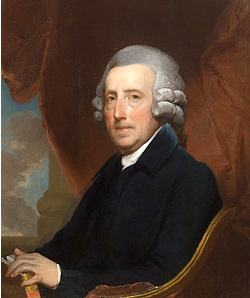
Thomas Dawes was a Patriot who served as a Massachusetts militia colonel during the American Revolution and afterward assumed prominent positions in Massachusetts's government. His positions included membership and chairmanship of the Massachusetts Governor's Council and representative in both the House and Senate. As chairman of the Governor's Council, Dawes served briefly as the de jure presiding officer of the executive branch of Massachusetts' state government for ten days – May 20, 1800 to May 30, 1800 – following the death of first Governor Increase Sumner and then Lieutenant Governor Moses Gill.
The Journal of Occurrences, also known as Journal of the Times and Journal of Transactions in Boston, was a series of newspaper articles published from 1768 to 1769 in the New York Journal and Packet and other newspapers, chronicling the occupation of Boston by the British Army. Authorship of the articles was anonymous, but is usually attributed to Samuel Adams, then the clerk of the Massachusetts House of Representatives. William Cooper, Boston's town clerk, has also been named as a possible author. The articles may have been written by a group of people working in collaboration.
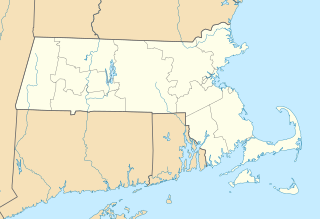
Fort Independence is a granite bastion fort that provided harbor defenses for Boston, Massachusetts. Located on Castle Island, Fort Independence is one of the oldest continuously fortified sites of English origin in the United States. The first primitive fortification, called "The Castle", was placed on the site in 1634 and, after two re-buildings, replaced circa 1692 with a more substantial structure known as Castle William. Re-built after it was abandoned by the British during the American Revolution, Castle William was renamed Fort Adams and then Fort Independence. The existing granite fort was constructed between 1833 and 1851. Today it is preserved as a state park and fires occasional ceremonial salutes. Fort Independence was added to the National Register of Historic Places in 1970.
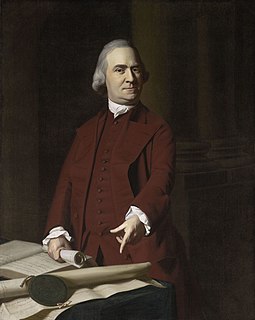
Samuel Adams was an American statesman, political philosopher, and one of the Founding Fathers of the United States. He was a politician in colonial Massachusetts, a leader of the movement that became the American Revolution, and one of the architects of the principles of American republicanism that shaped the political culture of the United States. He was a second cousin to his fellow Founding Father, President John Adams.
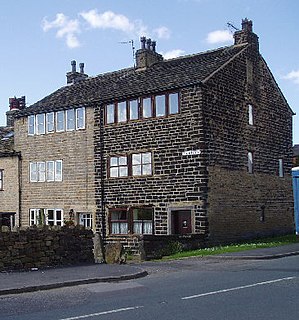
A weavers' cottage was a type of house used by weavers for cloth production in the putting-out system sometimes known as the domestic system.
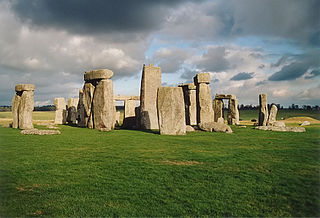
William Carpenter was a co-founder of Rhode Island and Providence Plantations, born about 1610, probably in Amesbury, Wiltshire, England. He died September 7, 1685 in the Pawtuxet section of Providence, now in Cranston, Rhode Island. He was listed by 1655 as a "freeman" of the colony.

Samuel Cooper was a Congregational minister in Boston, Massachusetts, affiliated with the Brattle Street Church. He was born in Boston to William Cooper and Judith Sewall, attended the Boston Latin School, and was graduated from Harvard College in 1743. He was ordained as a minister on May 21, 1746, and served as pastor of the Brattle Street Church, 1747-1783. Members of his parish at the Brattle St. Church included some of the most influential people of the American Revolution: John Hancock, Samuel Adams, Joseph Warren, John Adams, and others. He corresponded with Benjamin Franklin, Charles Hector d'Estaing, Gideon Hawley, Charles Gravier de Vergennes; and was associated with Phillis Wheatley. In 1780, he co-founded the American Academy of Arts and Sciences. He served as "chaplain to the General Court" 1758-1770 and 1777-1783. Around 1783 Harvard College offered Cooper the position of college president, but Cooper declined. In September 1746 he married Judith Bulfinch; they had two daughters. A portrait of Cooper by John Singleton Copley now resides in the collection of the Massachusetts Historical Society.

The Montgomery Guards were an Irish-American militia company that formed in Boston in 1837 and were forced to disband the following year due to extreme nativist and anti-Catholic sentiment in the city.

The Massachusetts Convention of Towns was an extralegal assembly held in Boston in response to the news that British troops would soon be arriving to crack down on anti-British rioting. Delegates from 96 Massachusetts towns gathered in Faneuil Hall to discuss their options. The more militant faction, led by James Otis Jr., Samuel Adams, and John Hancock, wanted to organize an armed resistance. The more conservative faction, led by convention chairman Thomas Cushing, preferred to lodge a written complaint. The conservatives won out, and the delegates endorsed a series of mild resolutions before disbanding.

